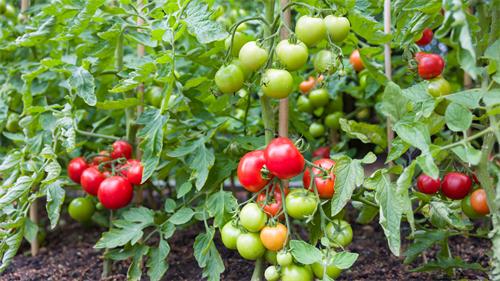
Tomatoes are a favorite among gardeners, offering juicy, flavorful fruits that enhance countless dishes. However, achieving a bountiful tomato harvest requires more than just planting and watering; understanding and addressing nutrient deficiencies is crucial. By recognizing the signs of nutrient imbalances and implementing effective solutions, you can ensure your tomato plants thrive throughout the growing season.
Tomato plants require a balanced mix of macronutrients—nitrogen (N), phosphorus (P), potassium (K), calcium (Ca), magnesium (Mg), and sulfur (S)—along with micronutrients like iron (Fe), manganese (Mn), zinc (Zn), copper (Cu), boron (B), and molybdenum (Mo). Each nutrient plays a specific role in plant development, from leaf growth to fruit production. Deficiencies in these nutrients can lead to visible symptoms and reduced yields.
Common Nutrient Deficiencies and Their Symptoms
● Nitrogen (N): A deficiency in nitrogen often results in older leaves turning pale green or yellow, stunted growth, and reduced vigor. As the deficiency progresses, younger leaves may also become discolored, and the plant may shed leaves due to insufficient energy.
● Phosphorus (P): Insufficient phosphorus can cause leaves to develop a dark green or purplish tint, particularly on the undersides, and lead to stunted growth and delayed flowering.
● Potassium (K): A lack of potassium manifests as yellowing or browning at the edges of older leaves, which may curl and become brittle. Fruit development can also be adversely affected, leading to poor yields.
● Calcium (Ca): Dark, sunken areas at the fruit's bloom end are a common sign of blossom-end rot, which is frequently linked to calcium shortage. Poor calcium uptake and uneven watering can make this problem worse.
● Magnesium (Mg): Magnesium deficiency leads to interveinal chlorosis, where the areas between leaf veins turn yellow while the veins remain green. Older leaves are typically affected first.
● Iron (Fe): Iron deficiency causes young leaves to exhibit interveinal chlorosis, resulting in yellowing between the veins while the veins themselves stay green. High soil pH values that restrict iron availability are frequently the cause of this disease.
Diagnosing Nutrient Deficiencies
Accurate diagnosis is essential for effective treatment. Regularly inspect your tomato plants for signs of nutrient deficiencies, paying close attention to leaf color, growth patterns, and fruit development. Conducting a soil test can provide valuable information about nutrient levels and pH, guiding your fertilization strategy.
Understanding and addressing nutrient deficiencies in tomato plants is vital for a successful harvest. By recognizing the symptoms, conducting soil tests, and implementing appropriate treatments, you can ensure your tomato plants remain healthy and productive. Regular monitoring and proactive care will lead to vibrant plants and delicious fruits, making your gardening efforts truly rewarding.
Recommend:

Cultivating Your Patio Paradise: Cleaning, Sealing, and Styling a Green Oasis

4 rules to help you shop without regrets on Black Friday

Finding stability in a volatile financial world: Fed relief rebound

10 Quintessential Prague Experiences

